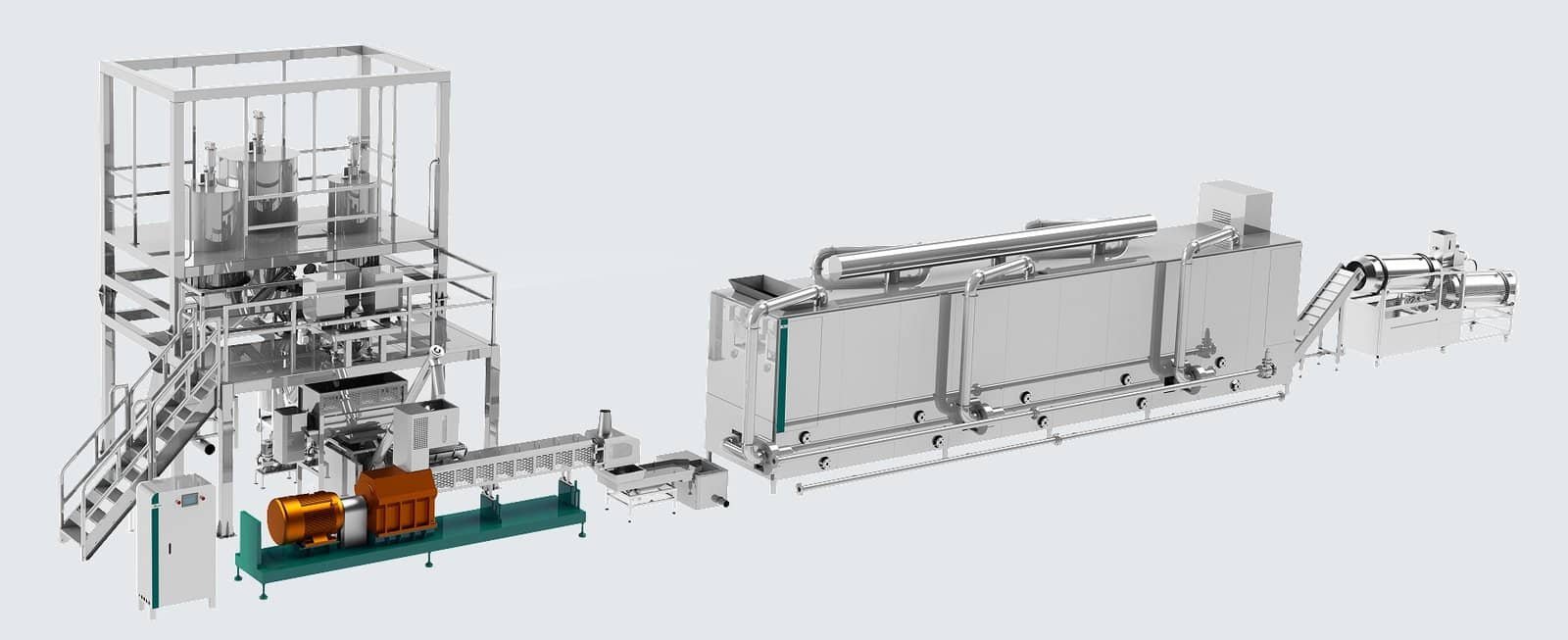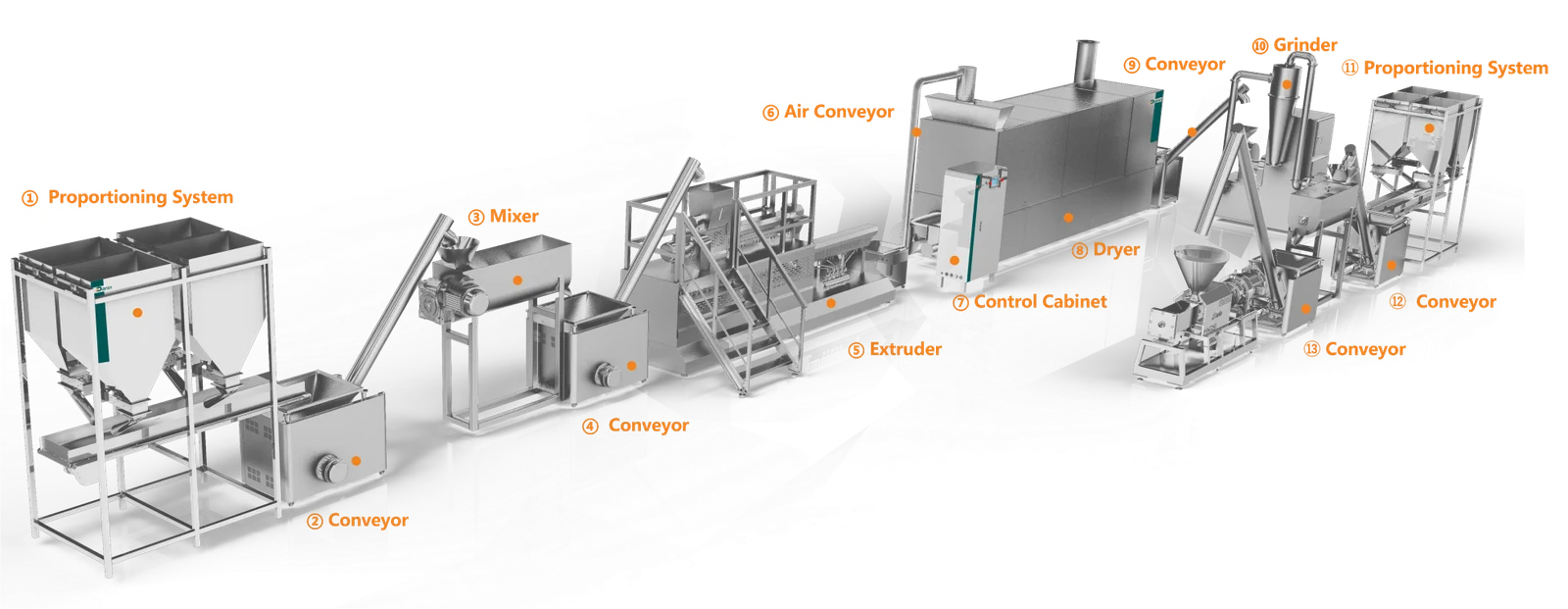
Pet food production is a complex process that requires high-quality machinery to ensure efficiency, consistency, and nutritional value in the final product. Manufacturers need to invest in reliable equipment to produce pet food that meets industry standards, consumer expectations, and animal health requirements. Without the right components, production can suffer from inefficiencies, contamination risks, and inconsistent product quality. Understanding the key components of pet food production machinery is essential for optimizing operations, reducing waste, and ensuring product safety.
The key components of pet food production machinery include raw material handling systems, grinding and mixing equipment, extrusion machines, drying and cooling systems, coating and flavoring units, and packaging machines. These components work together to transform raw ingredients into high-quality pet food products, ensuring consistency, safety, and nutritional balance. Each stage in the process plays a critical role in shaping the final product.
To produce high-quality pet food efficiently, manufacturers must use specialized equipment at each stage of production. Below, we explore the essential components of pet food production machinery, their functions, and why they are critical to the process.

1. Raw Material Handling Systems
Function:
Raw material handling is the initial stage in pet food production, where ingredients are received, stored, and transported to the processing line.
Key Equipment:
- Storage Silos: Used for bulk storage of grains, protein meals, and other dry ingredients.
- Hoppers and Conveyors: Move raw materials efficiently from storage to processing.
- Weighing and Batching Systems: Ensure precise ingredient measurements for consistent formulations.
Importance:
- Prevents contamination and spoilage.
- Ensures accurate recipe formulation.
- Enhances efficiency and reduces waste.
2. Grinding and Mixing Equipment
Function:
Grinding and mixing prepare raw ingredients for extrusion by breaking them down into fine particles and ensuring even distribution of nutrients.
Key Equipment:
- Hammer Mills or Roller Mills: Reduce raw materials into uniform particle sizes.
- Mixers (Ribbon Blenders, Paddle Mixers): Combine different ingredients evenly.
Importance:
- Improves digestibility and nutrient absorption.
- Ensures homogeneity in the final product.
- Enhances the extrusion process.
3. Extrusion Machines
Function:
Extrusion is the core process of pet food manufacturing, where mixed ingredients are cooked under high pressure and temperature, then shaped into kibble or other forms.
Key Equipment:
- Single-Screw or Twin-Screw Extruders: Process ingredients by applying heat, pressure, and shear force.
- Die Plates and Cutter Assemblies: Shape and size the extruded pet food.
Importance:
- Enhances food texture and palatability.
- Ensures proper cooking and nutrient retention.
- Allows for various pet food shapes and sizes.
4. Drying and Cooling Systems
Function:
Drying and cooling remove excess moisture to extend shelf life and prevent microbial growth.
Key Equipment:
- Belt Dryers or Rotary Dryers: Use hot air to reduce moisture content.
- Cooling Conveyors: Bring pet food to ambient temperature.
Importance:
- Prevents mold growth and spoilage.
- Ensures crispiness and desired texture.
- Increases product stability and storage life.
5. Coating and Flavoring Units
Function:
Coating and flavoring systems enhance taste, appearance, and nutritional value by adding fats, oils, vitamins, and palatants.
Key Equipment:
- Liquid Coaters and Sprayers: Apply fats and oils evenly.
- Powder Coaters: Distribute dry flavorings and vitamins.
Importance:
- Improves palatability and attractiveness to pets.
- Ensures uniform nutrient application.
- Enhances aroma and taste appeal.
6. Packaging Machines
Function:
Packaging ensures that pet food remains fresh, protected, and market-ready.
Key Equipment:
- Bagging and Sealing Machines: Automate filling and sealing of packages.
- Vacuum and Modified Atmosphere Packaging (MAP): Extend shelf life.
- Labeling and Coding Systems: Provide product information and batch tracking.
Importance:
- Preserves freshness and prevents contamination.
- Enhances brand presentation and compliance with regulations.
- Allows efficient distribution and storage.
Comparative Overview of Pet Food Production Machinery Components
| Component | Function | Key Equipment | Benefits |
|---|---|---|---|
| Raw Material Handling | Receiving, storing, and transporting ingredients | Storage silos, conveyors, weighing systems | Prevents contamination, ensures accurate formulation |
| Grinding and Mixing | Prepares ingredients for extrusion | Hammer mills, ribbon mixers | Improves digestibility, ensures uniformity |
| Extrusion | Shapes and cooks pet food | Single/twin-screw extruders, die plates | Enhances texture, ensures nutrient retention |
| Drying and Cooling | Removes moisture to prolong shelf life | Belt dryers, cooling conveyors | Prevents spoilage, stabilizes product |
| Coating and Flavoring | Adds fats, oils, and nutrients | Liquid sprayers, powder coaters | Enhances taste, ensures nutrient application |
| Packaging | Protects and markets final product | Bagging machines, MAP systems | Preserves freshness, facilitates distribution |
Conclusion
The key components of pet food production machinery play an integral role in ensuring efficient, safe, and high-quality manufacturing. From raw material handling to packaging, each stage must be optimized to maintain consistency, nutritional integrity, and consumer satisfaction. Investing in high-quality machinery not only improves productivity but also enhances product quality and market competitiveness.
If you're looking for expert guidance on pet food production machinery, contact us today. We provide cutting-edge solutions tailored to your needs, ensuring efficiency and superior product output!










